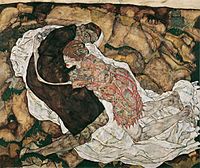|
Death and the Maiden (motif)
 Death and the Maiden (Der Tod und das Mädchen in German) was a common motif in Renaissance art, especially in German painting and printmaking. The usual form shows just two figures, with a young woman being seized by a personification of Death, often shown as a skeleton. Variants may include other figures. It developed from the Danse Macabre with an added erotic subtext. The German artist Hans Baldung depicted it several times.[1] The motif was revived during the romantic era in the arts, a notable example being Franz Schubert's song "Der Tod und das Mädchen", setting a poem by the German poet Matthias Claudius. Part of the piano part was re-used in Schubert's famous String Quartet No. 14, which is therefore also known by this title, in either English or German.[1] Selected versions
Gallery
NotesExternal links
|









